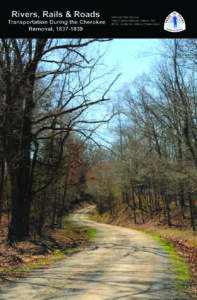The National Trail of Tears Association provided the following highlights for the Trail of Tears NHT during the 2021 calendar year:
Collaboration and Engagement

Cover of the booklet created under the direction of Amy Kostine by Middle Tennessee State University. Courtesy Office of Historic Preservation for NPS.
In June 2021, the Center for Historic Preservation at Middle Tennessee State University (MTSU-CHP) completed and submitted to the National Park Service, National Trails office (NTIR) a 138-page report on the transportation systems used during the Cherokee removal. The introduction to the report reads: “The Trail of Tears involved mile after mile of hard travel through miserable conditions. Yet detachments bound for Indian Territory did more than just walk. Although time-honored methods like wagons, keelboats, flatboats, and ferries played major roles, some of the technology used to transport Cherokees on the Trail of Tears was actually quite new.” MTSU-CHP created and published an interpretive booklet on the Cherokee’s transportation experience on the Trail of Tears, entitled “Rivers, Rails & Roads: Transportation During the Cherokee Removal, 1837-1839,” which is posted on the NTIR Trail of Tears website here: https://www.nps.gov/articles/000/rivers-rails-roads-transportation-during-the-cherokee-removal-1837-1839.htm
Strengthening Organizations and Partnerships
Undeterred by travel restrictions necessitated by the Covid-19 virus, the TOTA Board of Directors moved ahead with development of a Strategic Plan. Seven Sisters Consulting, a firm with a deep background working with Tribes and Tribal-related entities facilitated sessions spanning three days in August.
Seven Sisters facilitated creation of a Strategic Plan in 2016 which proved a very useful tool for measuring progress and guiding activities. The recent sessions utilized the previous plan as a base from which to move ahead. Board Members, together with Chapter Presidents, worked through the process of refining the organization’s mission statement and statement of purpose to create a plan to guide the organization over the next 3 three years. NPS Long Distance Trail Office personnel also attended and provided input.
In advance of the intense cyber meetings via Zoom, participants responded to questionnaires developed by Seven Sisters staff in consultation with Trail of Tears Staff and TOTA Secretary Patsy Edgar. This preliminary process guided the facilitators in preparation of documents which provided a framework for the online sessions.
The Associations leaders managed to create a very useful document via virtual meetings, which was officially approved by the Board at its Fall Meeting. Association Staff are currently organizing materials to aide committee chairmen in organizing their work, coordinating communication among several committees and reporting their progress.
Education, Interpretation and Cultural Expression
The National Park Service, National Trails office (NTIR), in partnership with the Tennessee Valley Authority (TVA), South East Tennessee Development District (SETDD), and Trail of Tears Association (TOTA) completed a project that funded the design and development of a trailhead, ¼-mile Trail of Tears National Historic Trail retracement trail and interpretive area at the historic Blythe Ferry site, in Meigs County, Tennessee. This new trailhead and ADA trail is open for public visitation and can be accessed from the parking lot of the Cherokee Removal Memorial Park. Interpretive waysides are being designed for the site which highlight the location where approximately 9,000 Cherokees, 500 Creeks and 127 slaves crossed the Hiawassee River on Blythe Ferry in 1838, leaving their homeland behind.
Other Highlights
The question “Where does the Trail of Tears begin?” is often answered by historians with “At the cabin door of the Cherokee families who were forced from their homes”. While it is not at all practical to mark all of the thousands of routes taken by each person removed from their homes during the Trail of Tears, much can be gained by illuminating the dark story of the forced removal with details of what Cherokee Citizens left behind at their homesteads.
In the late summer of 1838, while held in concentration camps at Fort Cass, GA and Fort Payne, AL, the men who would be leaders of the detachment groups acted as “Agents” for the dispossessed Cherokees and prepared Claims against the US for their improvements. These documents, identified as the 1838 Claims, often state the number of acres under cultivation, the size and type of structure of homes, barns, corncribs, and other outbuildings, as well as the number and variety of orchards on the land. They also state the stream upon which the Cherokee resided and the name of the town where they lived.
Mike Wren, a long time researcher, spent over 1,000 hours to compile a spreadsheet containing nearly 4,000 claims which he donated to the Trail of Tears Association. Association President Jack Baker coordinated the gathering of digital copies of the original Claims, which are scattered around the country in six different locations, and the gathering of permissions from the institutions holding those documents to utilize them.
Mr. Wren continued to donate his expertise as he and Jack Baker consulted with Megaphone Pro to utilize the spreadsheet to create a searchable database now available to the public via the TOTA website. Much info about Cherokees that was previously not accessible, is now available to researches, TOTA members, and the general public via the Association’s website. The Association considers this availability a giant leap in the process of telling the story of the Trail of Tears as it crosses the landscape.